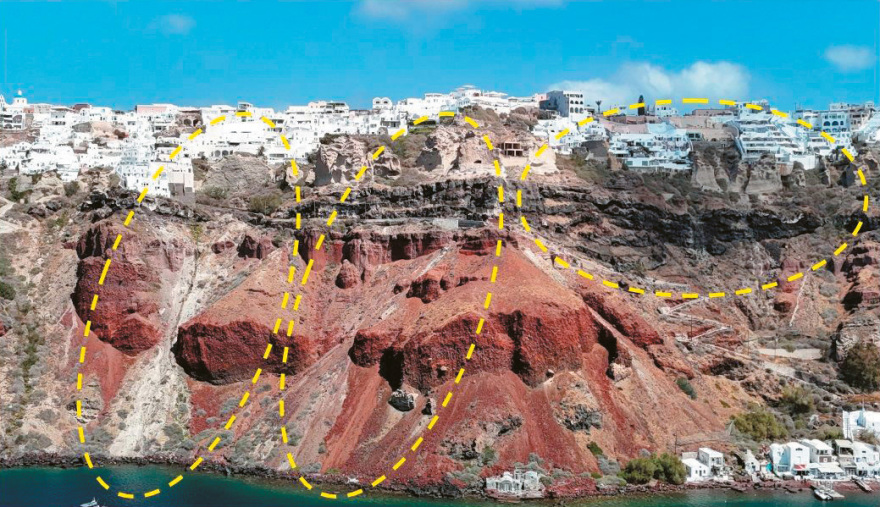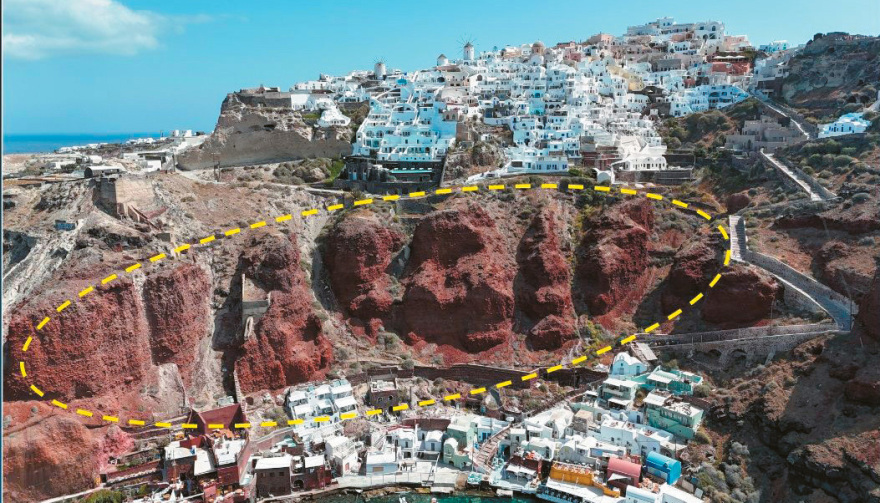Pools and concrete sink the caldera in Santorini
- Written by E.Tsiliopoulos
The view in the beautiful Imerovigli, of the white houses seemingly floating above the Caldera, was abruptly interrupted last Sunday by the roar of rocks that detached and tumbled forcefully down the cliff. Tourists enjoying the sunset panicked and rushed to safety, while locals recorded the terrifying moments on their phones. The video that circulated and was republished by international media vividly illustrates how fragile the balance is on the Aegean’s most famous island.
Experts were not surprised. Scientific teams have mapped every inch of Santorini in recent years, studying its unique geology. As they emphasize, the island is a “living” volcanic field, with terrain under constant stress. Last winter’s earthquakes left deep marks, further eroding the delicate slopes and increasing the likelihood of new landslides.
Overbuilding Rally
Nature, however, is not solely responsible. In Santorini, an informal “development race” has been ongoing for decades, leading to unchecked overbuilding. The tourism boom turned the island into one of the world’s most popular destinations, but the relentless construction of hotels, rental rooms, roads, and infrastructure has multiplied the pressures on an already fragile terrain.
Areas that were once rocky slopes now host entire complexes with pools and jacuzzis on the cliff edge, offering “killer views.” “Santorini has been built to a degree that exceeds its resilience,” warn seismologists and geologists who have been monitoring the island for years.
“Increasingly Dangerous”
Landslides are not rare in Santorini. Recently, however, their frequency has increased, as incidents recorded after last winter’s earthquakes show. In Imerovigli, Oia, and other points of the Caldera, smaller or larger pieces of rock are giving way, often close to houses or tourist accommodations. The island’s geomorphology makes it vulnerable. The steep slopes, formed by the great volcanic eruption thousands of years ago, are particularly sensitive to erosion and detachment. The pressure of overbuilding acts as a risk multiplier. “It’s not that the phenomenon appeared suddenly,” scientists explain. “It’s just that today human interventions amplify it and make it more dangerous.”
After the Imerovigli landslide, new cracks appeared in the rocks, which could trigger further collapses in the future.
Water from the Pools
Residents of Imerovigli, however, see another cause for the problem. They claim that it is not only overbuilding destabilizing the ground, but also a common practice among many local accommodations: draining pool water directly onto the cliff. According to them, each time the tanks are emptied, huge quantities of water penetrate the rocky substrate, softening the soil and gradually eroding the slopes.
Between the two lies a delicate balance, increasingly destabilized. Santorini, a top global destination, risks sacrificing its uniqueness on the altar of uncontrolled development. Experts warn that without strategic planning and effective protective measures, landslides will multiply, posing dangers not only to visitors and residents but also to the island’s very identity.
On-Site Inspection in Imerovigli
An on-site inspection in Imerovigli, at the exact location of the landslide, clearly illustrates the magnitude of the problem facing Santorini’s Caldera. The first image shows a large construction in progress, literally built on the cliff edge. Work has paused due to the summer season, but this does not change the fact that during winter months, before or after the seismic activity recorded on the island, there was intense construction activity.
As geologists explain, such interventions severely burden the slope, as all water from the construction sites and pools drains onto the rocks, leading to erosion and gradual weakening of the soil. The second image, from Google Maps, marks in red the point of the landslide.
At that exact spot, a large dust cloud formed, covering hotels and tourist units directly above – an image captured in video by residents and tourists who witnessed the event. According to scientists, this part of the Caldera is particularly sensitive due to its geological composition, while continuous construction has dramatically reduced its natural resilience.
Less worrying is the third image, taken next to a local hotel: visible cracks run through the rocks, revealing the pressure on the substrate.
Professor of Geology at the University of Patras, Evangelos Zelelidis, calmly notes that the recorded cracks could indeed cause small falls or landslides. “Yes, I see the fractures that could cause small falls-landslides. I’m not worried about something major, but a section could detach, similar to what happened. The rocks are such that these falls are expected, which is why steep slopes form,” he explains.
Experts emphasize that landslides in the Caldera cannot be considered isolated events. They are the culmination of a long-term process, where natural soil dynamics combine with intense human intervention. Continuous construction, excessive water use, and excavation burden an already sensitive environment with limited tolerance. “Nature reacts in its own way,” they note, adding that without immediate protective measures, new landslides are very likely, with unpredictable consequences for infrastructure in hazardous areas and human safety.
Professor Evangelos Zelelidis adds that every new human intervention further stresses the already burdened slope. “Yes, each new intervention increases the load on the already stressed slope. It’s not just the gravitational load, but also water that falls and pools behind retaining walls. This water then saturates the underlying rocks, loosens the material bonds, and can trigger small landslides,” he notes.
What the Municipality Says
At the same time, the Municipality of Thira, in a statement issued regarding the incident in Imerovigli, appears reassuring, claiming that according to the assessments of the responsible authorities, there is no issue of danger. As emphasized, soil detachments on the slopes of the Caldera are not considered unusual, as they are related to the island’s geological peculiarity. The municipality also clarifies that no construction works are taking place in the area, as there is an explicit ban on such activities during the tourist season.
Additionally, it is noted that in areas with residences and tourist facilities, protective nets and fences have been installed, and further interventions are planned under the Joint Ministerial Decision issued after the February earthquakes. As highlighted, incidents of this type, although they may attract attention, rarely pose an immediate risk to residents and visitors.
The municipality concludes that Santorini remains a safe and welcoming destination, with the relevant authorities closely monitoring developments and taking the necessary protective measures.
In the same area, on the cliff edge, new buildings are being erected, which – as experts note – add stress to the stability of the ground, as water drains directly onto the slopes.
The OASP Study
Images from the Imerovigli landslide, with the dust cloud covering hotels and tourist units on the cliff edge for a long period, confirmed what experts have been pointing out for months. Since last February, when the island experienced intense seismic activity, Professor of Dynamic Tectonics and Applied Geology and President of the Earthquake Planning and Protection Organization (OASP), Efthymios Lekkas, had presented well-documented data showing that the risk of landslides in the Santorini Caldera is extremely high.
In a broad meeting at the Ministry of Civil Protection, attended by the Prime Minister, the responsible minister, Professor of Geophysics Kostas Papazachos, and volcanologist Evi Nomikou, Mr. Lekkas had sounded the alarm: along almost the entire length of the slopes, there is an increased risk, with some areas considered “red zones.” Specifically, he highlighted Palaio Limani of Fira, the port of Athinios, the road network of Ormos, Oia (with emphasis on Ammoudi and Armeni), and Thirassia (Korfu settlement and the upstream area, Monopati).
The OASP study, based on geological and tectonic data, demonstrated that the instability of the Caldera is not just a theoretical possibility. Cracks and small collapses have already been recorded in many areas, proving that the phenomenon is ongoing. According to scientists, continuous interventions in recent years – road openings, excavations for new buildings, addition of heavy structures and water tanks at slope edges – act as accelerators of erosion, increasing soil vulnerability. After the Imerovigli landslide, Efthymios Lekkas personally visited the site for an on-site inspection”
According to reports, he submitted a detailed report to the responsible ministry with his findings and recommended specific immediate interventions. The experts’ recommendations include reinforcement works, restrictions on new constructions, and strict monitoring of water runoff directed onto the slopes, either from construction activities or from the dozens of pools and jacuzzis installed atop the cliffs.

The professor’s visit to Imerovigli also tied into earlier OASP studies, confirming that his warnings were not theoretical but reflected a real threat. The collapse of the slope at that specific point adds another link in the chain of events demonstrating the fragility of Santorini’s landscape. As scientists emphasize, the phenomenon is not isolated; it is the culmination of a long process with excessive human activity in an already naturally unstable environment as a common denominator.


High-risk areas for landslides in Santorini, as identified by OASP last February when the island experienced intense and continuous seismic activity.
Persistent Lack of Oversight
Discussion about the stability of buildings and the safety of the Caldera did not start now. As early as the early 1990s, the first serious studies by the Directorate of Residential Housing and Building Regulations (DOKK) had highlighted the risks posed by uncontrolled construction and gradual overbuilding on the volcanic slope. Experts warned that the region’s unique geomorphology, combined with unchecked development, could have disastrous consequences in the future.
A few years later, in 2000, the Ombudsman’s report confirmed these fears, citing uncontrolled tourist development and lack of strict oversight that had turned the Caldera’s edge into a congested urban area. Essentially, constructions there ignored both the geological reality and basic safety principles. Despite timely warnings, overbuilding not only continued but accelerated, especially after the tourism boom of recent decades.
Buildings sprout atop geologically vulnerable points in Santorini
Today, the Caldera remains visually impressive, but behind the “miracle” lies a fragile foundation. A telling example is a location where a building destroyed in the catastrophic 1956 earthquake is being rebuilt, while directly above, within a few meters, rental rooms sit with small balconies featuring jacuzzis whose edges seem to float literally over the void – a striking image of how tourism development coexists with geological risk.
Related items
-
 Kyriakos Pierrakakis unanimously elected President of the Eurogroup
Kyriakos Pierrakakis unanimously elected President of the Eurogroup
-
 Horror in Nea Michaniona: 90-year-old man buried his daughter's dog alive after taping its mouth shut
Horror in Nea Michaniona: 90-year-old man buried his daughter's dog alive after taping its mouth shut
-
 New rumors about Antetokounmpo's future: He bought an eight-story building in New York
New rumors about Antetokounmpo's future: He bought an eight-story building in New York
-
 Voting time for Pierrakakis and van Petegem in the battle for Eurogroup leadership - The process and the factors that will determine the outcome
Voting time for Pierrakakis and van Petegem in the battle for Eurogroup leadership - The process and the factors that will determine the outcome
-
 Nephew and businessman to the prosecutor for the murder at the Finikounda campsite: How the authorities arrived at their arrest
Nephew and businessman to the prosecutor for the murder at the Finikounda campsite: How the authorities arrived at their arrest
Latest from E.Tsiliopoulos
- Mitsotakis: A day of pride for Greece, the government, and all citizens with the election of Pierrakakis
- Kyriakos Pierrakakis unanimously elected President of the Eurogroup
- Horror in Nea Michaniona: 90-year-old man buried his daughter's dog alive after taping its mouth shut
- New rumors about Antetokounmpo's future: He bought an eight-story building in New York
- Voting time for Pierrakakis and van Petegem in the battle for Eurogroup leadership - The process and the factors that will determine the outcome

